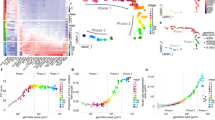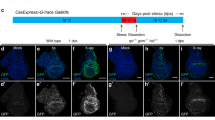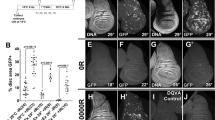Abstract
Cell death is a prominent feature of animal germline development. In Drosophila, the death of 15 nurse cells is linked to the development of each oocyte. In addition, females respond to poor environmental conditions by inducing egg chamber death prior to yolk uptake by the oocyte. To study these two forms of cell death, we analyzed caspase activity in the germline by expressing a transgene encoding a caspase cleavage site flanked by cyan fluorescent protein and yellow fluorescent protein. When expressed in ovaries undergoing starvation-induced apoptosis, this construct was an accurate reporter of caspase activity. However, dying nurse cells at the end of normal oogenesis showed no evidence of cytoplasmic caspase activity. Furthermore, although expression of the caspase inhibitors p35 or Drosophila inhibitor of apoptosis protein 1 blocked starvation-induced death, it did not affect normal nurse cell death or overall oogenesis in well-fed females. Our data suggest that caspases play no role in developmentally programmed nurse cell death.
Similar content being viewed by others
Log in or create a free account to read this content
Gain free access to this article, as well as selected content from this journal and more on nature.com
or
Abbreviations
- CFP:
-
cyan fluorescent protein
- Dcp-1:
-
death caspase-1
- Diap1:
-
Drosophila inhibitor of apoptosis protein 1 (thread, FBgn 0003691)
- GFP:
-
green fluorescent protein
- YFP:
-
yellow fluorescent protein
References
Baum JS, St George JP and McCall K (2005) Programmed cell death in the germline. Semin. Cell Dev. Biol. 16: 245–259.
Tilly JL (2001) Commuting the death sentence: how oocytes strive to survive. Nat. Rev. Mol. Cell Biol. 2: 838–848.
Cavaliere V, Taddei C and Gargiulo G (1998) Apoptosis of nurse cells at the late stages of oogenesis of Drosophila melanogaster. Dev. Genes Evol. 208: 106–112.
Foley K and Cooley L (1998) Apoptosis in late stage Drosophila nurse cells does not require genes within the H99 deficiency. Development 125: 1075–1082.
Nezis IP, Stravopodis DJ, Papassideri I, Robert-Nicoud M and Margaritis LH (2000) Stage-specific apoptotic patterns during Drosophila oogenesis. Eur. J. Cell Biol. 79: 610–620.
Nicholson DW and Thornberry NA (1997) Caspases: killer proteases. Trends Biochem. Sci. 22: 299–306.
Schwartz LM and Ashwell JD (eds) (2001) Apoptosis. Method Cell Biol. (San Diego, CA: Academic Press) Vol. 66.
Gumienny TL, Lambie E, Hartwieg E, Horvitz HR and Hengartner MO (1999) Genetic control of programmed cell death in the Caenorhabditis elegans hermaphrodite germline. Development 126: 1011–1022.
Mangahas PM and Zhou Z (2005) Clearance of apoptotic cells in Caenorhabditis elegans. Semin. Cell Dev. Biol. 16: 295–306.
Bangs P, Franc N and White K (2000) Molecular mechanisms of cell death and phagocytosis in Drosophila. Cell Death Differ. 7: 1027–1034.
McCall K and Steller H (1998) Requirement for DCP-1 caspase during Drosophila oogenesis. Science 279: 230–234.
Peterson JS, Barkett M and McCall K (2003) Stage-specific regulation of caspase activity in Drosophila oogenesis. Dev. Biol. 260: 113–123.
Leulier F, Rodriguez A, Khush RS, Abrams JM and Lemaitre B (2000) The Drosophila caspase Dredd is required to resist gram-negative bacterial infection. EMBO Rep. 1: 353–358.
Chew SK, Akdemir F, Chen P, Lu WJ, Mills K, Daish T, Kumar S, Rodriguez A and Abrams JM (2004) The apical caspase dronc governs programmed and unprogrammed cell death in Drosophila. Dev. Cell 7: 897–907.
Daish TJ, Mills K and Kumar S (2004) Drosophila caspase DRONC is required for specific developmental cell death pathways and stress-induced apoptosis. Dev. Cell 7: 909–915.
Xu D, Li Y, Arcaro M, Lackey M and Bergmann A (2005) The CARD-carrying caspase Dronc is essential for most, but not all, developmental cell death in Drosophila. Development 132: 2125–2134.
Drysdale RA, Crosby MA, Gelbart W, Campbell K, Emmert D, Matthews B, Russo S, Schroeder A, Smutniak F, Zhang P, Zhou P, Zytkovicz M, Ashburner M, de Grey A, Foulger R, Millburn G, Sutherland D, Yamada C, Kaufman T, Matthews K, DeAngelo A, Cook RK, Gilbert D, Goodman J, Grumbling G, Sheth H, Strelets V, Rubin G, Gibson M, Harris N, Lewis S, Misra S and Shu SQ (2005) FlyBase: genes and gene models. Nucleic Acids Res. 33: D390–D395.
Laundrie B, Peterson JS, Baum JS, Chang JC, Fileppo D, Thompson SR and McCall K (2003) Germline cell death is inhibited by P-element insertions disrupting the dcp-1/pita nested gene pair in Drosophila. Genetics 165: 1881–1888.
Drummond-Barbosa D and Spradling AC (2001) Stem cells and their progeny respond to nutritional changes during Drosophila oogenesis. Dev. Biol. 231: 265–278.
Buszczak M, Lu X, Segraves WA, Chang TY and Cooley L (2002) Mutations in the midway gene disrupt a Drosophila acyl coenzyme A: diacylglycerol acyltransferase. Genetics 160: 1511–1518.
Giorgi F and Deri P (1976) Cell death in ovarian chambers of Drosophila melanogaster. J. Embryol. Exp. Morphol. 35: 521–533.
Muro I, Monser K and Clem RJ (2004) Mechanism of Dronc activation in Drosophila cells. J. Cell Sci 117: 5035–5041.
Di Fruscio M, Styhler S, Wikholm E, Boulanger MC, Lasko P and Richard S (2003) Kep1 interacts genetically with dredd/caspase-8, and kep1 mutants alter the balance of dredd isoforms. Proc. Natl. Acad. Sci. USA 100: 1814–1819.
Luo KQ, Yu VC, Pu Y and Chang DC (2001) Application of the fluorescence resonance energy transfer method for studying the dynamics of caspase-3 activation during UV-induced apoptosis in living HeLa cells. Biochem. Biophys. Res. Commun. 283: 1054–1060.
Rørth P (1998) Gal4 in the Drosophila female germline. Mech. Dev. 78: 113–118.
Cox RT and Spradling AC (2003) A Balbiani body and the fusome mediate mitochondrial inheritance during Drosophila oogenesis. Development 130: 1579–1590.
Werz C, Lee TV, Lee PL, Lackey M, Bolduc C, Stein DS and Bergmann A (2005) Mis-specified cells die by an active gene-directed process, and inhibition of this death results in cell fate transformation in Drosophila. Development 132: 5343–5352.
Chipuk JE and Green DR (2005) Opinion: do inducers of apoptosis trigger caspase-independent cell death? Nat. Rev. Mol. Cell Biol. 6: 268–275.
Sperandio S, de Belle I and Bredesen DE (2000) An alternative, nonapoptotic form of programmed cell death. Proc. Natl. Acad. Sci. USA 97: 14376–14381.
Degterev A, Huang Z, Boyce M, Li Y, Jagtap P, Mizushima N, Cuny GD, Mitchison TJ, Moskowitz MA and Yuan J (2005) Chemical inhibitor of nonapoptotic cell death with therapeutic potential for ischemic brain injury. Nat. Chem. Biol. 1: 112–119.
Edinger AL and Thompson CB (2004) Death by design: apoptosis, necrosis and autophagy. Curr. Opin. Cell Biol. 16: 663–669.
Rusten TE, Lindmo K, Juhasz G, Sass M, Seglen PO, Brech A and Stenmark H (2004) Programmed autophagy in the Drosophila fat body is induced by ecdysone through regulation of the PI3K pathway. Dev. Cell 7: 179–192.
Appelt U, Sheriff A, Gaipl US, Kalden JR, Voll RE and Herrmann M (2005) Viable, apoptotic and necrotic monocytes expose phosphatidylserine: cooperative binding of the ligand Annexin V to dying but not viable cells and implications for PS-dependent clearance. Cell Death Differ. 12: 194–196.
Didenko VV, Ngo H, Minchew CL, Boudreaux DJ, Widmayer MA and Baskin DS (2002) Caspase-3-dependent and -independent apoptosis in focal brain ischemia. Mol. Med. 8: 347–352.
Artal-Sanz M and Tavernarakis N (2005) Proteolytic mechanisms in necrotic cell death and neurodegeneration. FEBS Lett. 579: 3287–3296.
Monks J, Rosner D, Geske FJ, Lehman L, Hanson L, Neville MC and Fadok VA (2005) Epithelial cells as phagocytes: apoptotic epithelial cells are engulfed by mammary alveolar epithelial cells and repress inflammatory mediator release. Cell Death Differ. 12: 107–114.
Grieder NC, de Cuevas M and Spradling AC (2000) The fusome organizes the microtubule network during oocyte differentiation in Drosophila. Development 127: 4253–4264.
Piccin A, Salameh A, Benna C, Sandrelli F, Mazzotta G, Zordan M, Rosato E, Kyriacou CP and Costa R (2001) Efficient and heritable functional knock-out of an adult phenotype in Drosophila using a GAL4-driven hairpin RNA incorporating a heterologous spacer. Nucleic Acids Res. 29: E55.
Spradling A (1986) P element-mediated transformation In Drosophila: A Practical Approach Roberts DB (ed) (Oxford, Washington DC: IRL Press), 175–197.
Beall EL, Mahoney MB and Rio DC (2002) Identification and analysis of a hyperactive mutant form of Drosophila P-element transposase. Genetics 162: 217–227.
Singleton K and Woodruff RI (1994) The osmolarity of adult Drosophila hemolymph and its effect on oocyte-nurse cell electrical polarity. Dev. Biol. 161: 154–167.
Cooley L, Verheyen E and Ayers K (1992) Chickadee encodes a profilin required for intercellular cytoplasm transport during Drosophila oogenesis. Cell 69: 173–184.
Rasband WS ( http://rsb.info.nih.gov/ij/, Bethesda, MD, 1997–2005).
Acknowledgements
We thank members of the Cooley Lab for their helpful advice and discussions. We also thank Andreas Bergmann for sharing a Drosophila line containing UASp-p35 ahead of publication, Nathalie Franc for sending Crq antisera, Bruce Hay for p35 antisera, Mike Buszczak for obtaining plasmids that contained CFP and YFP sequences, and the staff of the Center for Cell and Molecular Imaging at Yale University for confocal microscope services. SM was supported by the James Hudson Brown – Alexander B. Coxe Postdoctoral Fellowship. LC is supported by NIH grant GM043301.
Author information
Authors and Affiliations
Corresponding author
Additional information
Edited by E Baehrecke
Supplementary Information accompanies the paper on Cell Death and Differentiation website (http://www.nature.com/cdd)
Supplementary information
Rights and permissions
About this article
Cite this article
Mazzalupo, S., Cooley, L. Illuminating the role of caspases during Drosophila oogenesis. Cell Death Differ 13, 1950–1959 (2006). https://doi.org/10.1038/sj.cdd.4401892
Received:
Revised:
Accepted:
Published:
Issue date:
DOI: https://doi.org/10.1038/sj.cdd.4401892
Keywords
This article is cited by
-
Nuclear degradation dynamics in a nonapoptotic programmed cell death
Cell Death & Differentiation (2020)
-
Non-apoptotic cell death in animal development
Cell Death & Differentiation (2017)
-
Vital staining for cell death identifies Atg9a-dependent necrosis in developmental bone formation in mouse
Nature Communications (2016)
-
Mad linker phosphorylations control the intensity and range of the BMP-activity gradient in developing Drosophila tissues
Scientific Reports (2014)



